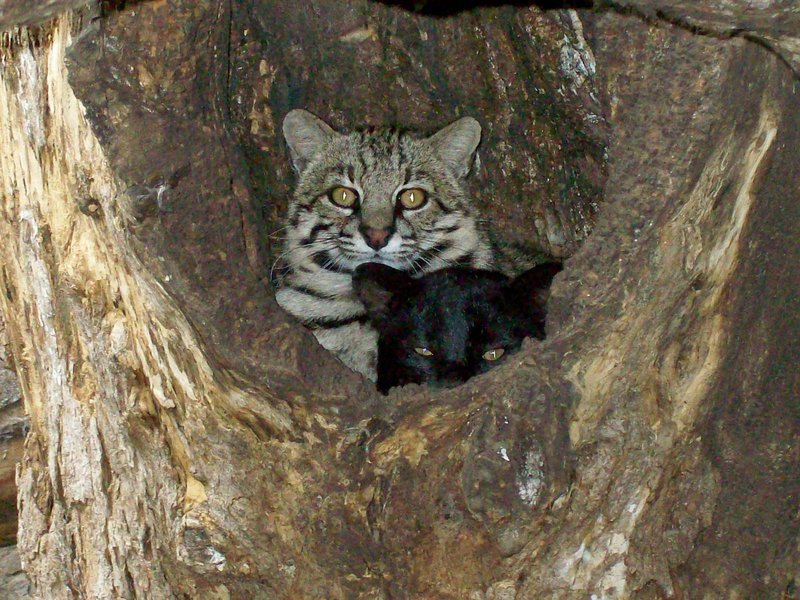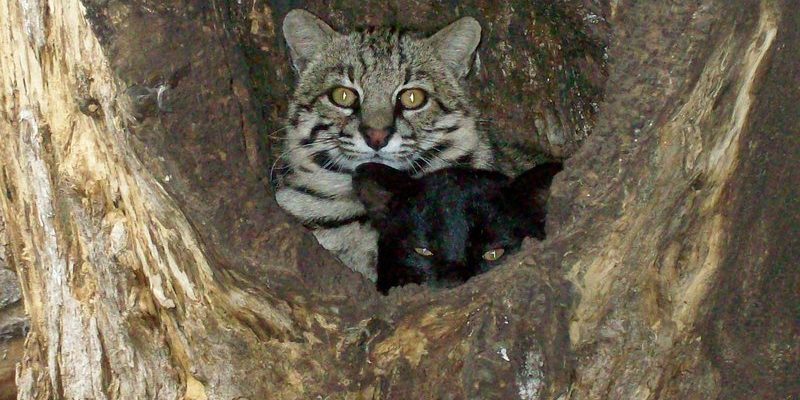
Imagine a small, lively cat with a wild heart and a penchant for mischief—meet the Geoffroy’s Cat. This fascinating little feline, native to the grasslands and forests of South America, packs a lot of personality into its compact size. They might be small, but these cats are spirited hunters, perfectly adapted to their environment. Think of them as the charming, adventurous cousins of house cats!
With their adorable looks and intriguing behavior, Geoffroy’s Cats have captured the interest of wildlife enthusiasts and researchers alike. Recognized for their striking spotted coat, they are often confused with domestic cats, yet they lead a life that’s anything but ordinary. Their playful nature and clever tactics in the wild make them a subject worth exploring in depth.
Physical Characteristics
Geoffroy’s Cats typically measure around 3.5 to 4.5 feet in length, including the tail, which can be about one-third of their body length. Weighing in at an average of 6 to 10 pounds, these cats are quite compact but well-muscled, giving them a robust appearance. Their fur is soft and usually features a gray-brown base with black spots, which helps provide excellent camouflage in their natural habitat. This pattern is not just for show; it’s a clever evolutionary trait that aids in hunting.
Habitat and Distribution
You can find the Geoffroy’s Cat primarily in the temperate forests, scrublands, and grasslands of South America. They thrive in countries such as Argentina, Brazil, Chile, and Paraguay. These cats prefer areas with dense vegetation, which allows them to stalk their prey with stealth. Think of it as their very own jungle gym, where every tree, bush, and rock becomes a playground for exploration.
Their adaptability is quite remarkable; they can live at elevations up to 3,000 meters in the Andes. In more open areas, they often seek cover in tall grasses or low shrubs. Unfortunately, as human activity encroaches on their territory, their habitat is increasingly at risk. Logging, agriculture, and urban development threaten the places where these charming cats thrive.
Diet and Hunting Behavior
When it comes to meals, Geoffroy’s Cats are adept hunters, primarily feeding on small mammals, birds, and even insects. Their diet reflects their opportunistic nature; they will hunt whatever is available in their environment. Picture a tiny predator stalking through the underbrush, quietly calculating the best moment to pounce on unsuspecting prey. This part of their nature showcases the wild spirit that makes them so captivating.
Thanks to their keen senses and agility, they are excellent climbers and often leap between branches to catch birds or small mammals. Their hunting strategy involves patience and stealth, waiting for the perfect opportunity to strike. They can even use their lush environment to their advantage, sneaking up on prey while hidden in the tall grass or behind foliage.
Social Behavior and Reproduction
Unlike some larger wild cats, Geoffroy’s Cats are relatively solitary creatures. They establish and defend their territory, with males having larger ranges than females. This behavior can be compared to living in a big apartment complex—everyone has their own space but keeps an eye on their neighbors. They communicate through scent marking and vocalizations, ensuring that others know they’re around.
Mating occurs typically in the spring, leading to a gestation period of about 70 to 80 days. Litters usually consist of one to four kittens, born blind and helpless. The mother is highly protective, caring for her young until they’re ready to explore the world. This nurturing side of their nature highlights the balance between their wild instincts and parental care.
Conservation Status
The Geoffroy’s Cat is currently classified as Near Threatened by the IUCN. While they are not yet endangered, factors like habitat loss and poaching pose significant threats. Their pelts are sometimes sought after, making them a target for illegal hunting. Conservation efforts are crucial to ensuring their survival, as preserving their natural habitats and raising awareness about their ecological importance can help mitigate these threats.
Various organizations are working to monitor populations and protect their habitats. Local awareness efforts focus on educating communities about the value of biodiversity and the need to coexist with wildlife. Every little bit helps, and by supporting these initiatives, we can play a part in safeguarding the future of the Geoffroy’s Cat.
Interesting Facts
- Color Variations: The patterns on their fur can vary quite a bit, making each Geoffroy’s Cat unique.
- Size Comparisons: They are often compared in size to a domestic cat, though more muscular and robust.
- Sound Signals: Their vocalizations can range from purring to hissing, much like our familiar house cats.
- Water Lovers: Surprisingly, these cats enjoy water and are often seen playing in streams or shallow ponds.
The Geoffroy’s Cat remains a captivating example of nature’s diversity and adaptability. With their engaging personalities, striking appearances, and vital role in their ecosystems, they remind us of the importance of preserving wildlife. As we learn more about them, we can better appreciate their significance and the need to protect their habitats. Every effort counts, and by sharing their story, we can spread awareness and encourage actions that lead to their conservation.
FAQ
What does a Geoffroy’s Cat look like?
Geoffroy’s Cats are small, wild felines with a spotted coat that serves as excellent camouflage. Their fur is generally a shade of gray-brown, accentuated by numerous black spots and stripes. They have large, expressive eyes and a compact physique, making them look a lot like a domestic cat, but with a more rugged appearance.
Where can you find Geoffroy’s Cats?
Geoffroy’s Cats inhabit various regions across South America, including parts of Argentina, Brazil, Chile, and Paraguay. They prefer dense vegetation in grasslands, scrublands, and temperate forests, where they can easily hunt and hide.
Are Geoffroy’s Cats endangered?
Currently, Geoffroy’s Cats are classified as Near Threatened. Although they are not critically endangered, their populations are declining due to habitat loss, poaching, and illegal hunting for their pelts. Conservation efforts are in place to protect their habitats and raise awareness about their ecological importance.
What do Geoffroy’s Cats eat?
These agile hunters primarily feed on small mammals, birds, and insects. They are opportunistic and will take advantage of whatever prey is available in their environment, showcasing their adaptability and hunting prowess.
How do Geoffroy’s Cats communicate?
Geoffroy’s Cats communicate through a mix of vocalizations and scent marking. Their sounds range from purring to hissing, similar to domestic cats. They use scent marking to mark their territory and convey their presence to other cats in the area.
How big do Geoffroy’s Cats get?
Adult Geoffroy’s Cats typically measure between 3.5 to 4.5 feet in length, including their tails. They usually weigh between 6 to 10 pounds, making them relatively small compared to many other wild cats.
Do Geoffroy’s Cats socialize with other cats?
Generally, Geoffroy’s Cats are solitary creatures. They establish and maintain their territories, with male cats often having larger ranges than females. While they may come together during mating season, they usually prefer their own space.
Can Geoffroy’s Cats climb trees?
Yes, Geoffroy’s Cats are excellent climbers! Their strong legs and agile bodies enable them to navigate trees with ease, helping them hunt birds and escape potential threats.
What is the average lifespan of a Geoffroy’s Cat?
In the wild, Geoffroy’s Cats typically have a lifespan of around 10 to 12 years. However, in captivity, with proper care and no threats from predators, they may live even longer, sometimes exceeding 15 years.
How do Geoffroy’s Cats care for their young?
The mother Geoffroy’s Cat is very nurturing and protective of her kittens. After a gestation period of about 70 to 80 days, she typically gives birth to one to four kittens. She raises them alone, teaching them essential survival skills until they are ready to fend for themselves.
Are Geoffroy’s Cats friendly toward humans?
Geoffroy’s Cats are generally shy and elusive around humans. While they may be curious, they are wild animals and not domesticated. If encountered in the wild, it’s best to observe them from a distance and respect their space.
What threats do Geoffroy’s Cats face in the wild?
Geoffroy’s Cats face several threats, including habitat destruction due to agriculture, logging, and urban development. Additionally, poaching for their pelts poses a significant danger, contributing to their declining populations.
What steps are being taken to conserve Geoffroy’s Cats?
Conservation efforts include habitat protection, awareness campaigns, and monitoring of populations. Various organizations work to educate local communities about the importance of protecting these fascinating cats and the ecosystems they inhabit.

